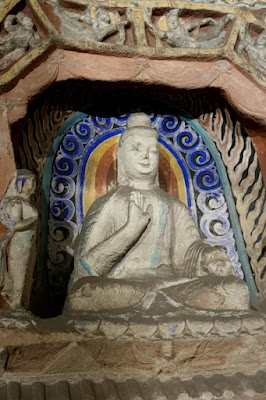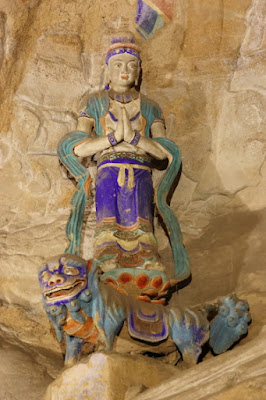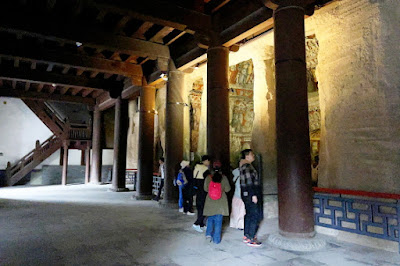 |
| Picture by Heather |
While we were in China, we decided to visit Yungang Grottoes that are located near the Wuzhou Shan Mountains, 16 km (10 miles ) from Datong. The Grottoes are excellent examples of rock-cut architecture and one of the three most famous ancient Buddhist sculptural sites in China.
In 2001, Yungang Grottoes became a UNESCO World Heritage Site because it is considered to be a "masterpiece of early Chinese Buddhist cave art... [and] ...represent the successful fusion of Buddhist religious symbolic art from south and central Asia with Chinese cultural traditions, starting in the 5th century under Imperial auspices." Our guide book said: "The Grottoes are considered to be "one of the greatest ancient stone carving art treasure houses in the world."
The Northern Wei emperors and their families were patrons of the arts and started the rock carvings in 439 as the Imperial Grotto Temple of Northern Wei. However, in 494, most constriction stopped when the Northern Wei moved their capital to Luoyang to accommodate the Silk Road trade. The site then passed into private ownership and some construction continued until 525 when the last carvings were made.
There are over a thousand caves at the site, with 254 of the caves containing more than 59,000 stone sculptures, but only a small number of the caves are open to the public.
 |
| Picture by Kolohe |
 |
| Picture by Kolohe |
 |
| Picture by Kolohe |
 |
| Picture by Heather |
There was a beautiful visitor center with original artwork and a gift shop where souvenirs could be purchased. I do not remember the meaning of the four-buddha statue, but the lighted buddhas could be purchased and taken home. Each lighted statue had been blessed and were religiously more significant that other buddhas that could be purchased.
 |
| Picture by Kolohe |
Just outside of the visitor center was a large courtyard with various statues. I think one was of the statues was Confucius.
 |
| Picture by Kolohe |
 |
| Picture by Kolohe |
 |
| Picture by Heather |
After passing through a pavilion with large iron doors, the path continued between large columns that sit atop the backs of elephants. We were told that this architectural style reflects the spread of Buddhism to the east and the influence of western cultures. The Gandhara Buddhism Art combines ancient Indian art with Greek and Roman classical art that is found in some of the caves.
 |
| Picture by Heather |
 |
| Picture by Kolohe |
At the end of a long row of columns, there was a Buddhist Wishing Tree surrounded by a wall decorated with historic Chinese images. Just past the tree, the path continued over a bridge to a grouping of buildings on an island. Rather than following the path to the island, we decided to ride a tram that went directly to the Grottoes.
 |
| Picture by Heather |
 |
| Picture by Heather |
 |
| Picture by Kolohe |
 |
| Picture by Kolohe |
 |
| Picture by Kolohe |































































































































No comments:
Post a Comment